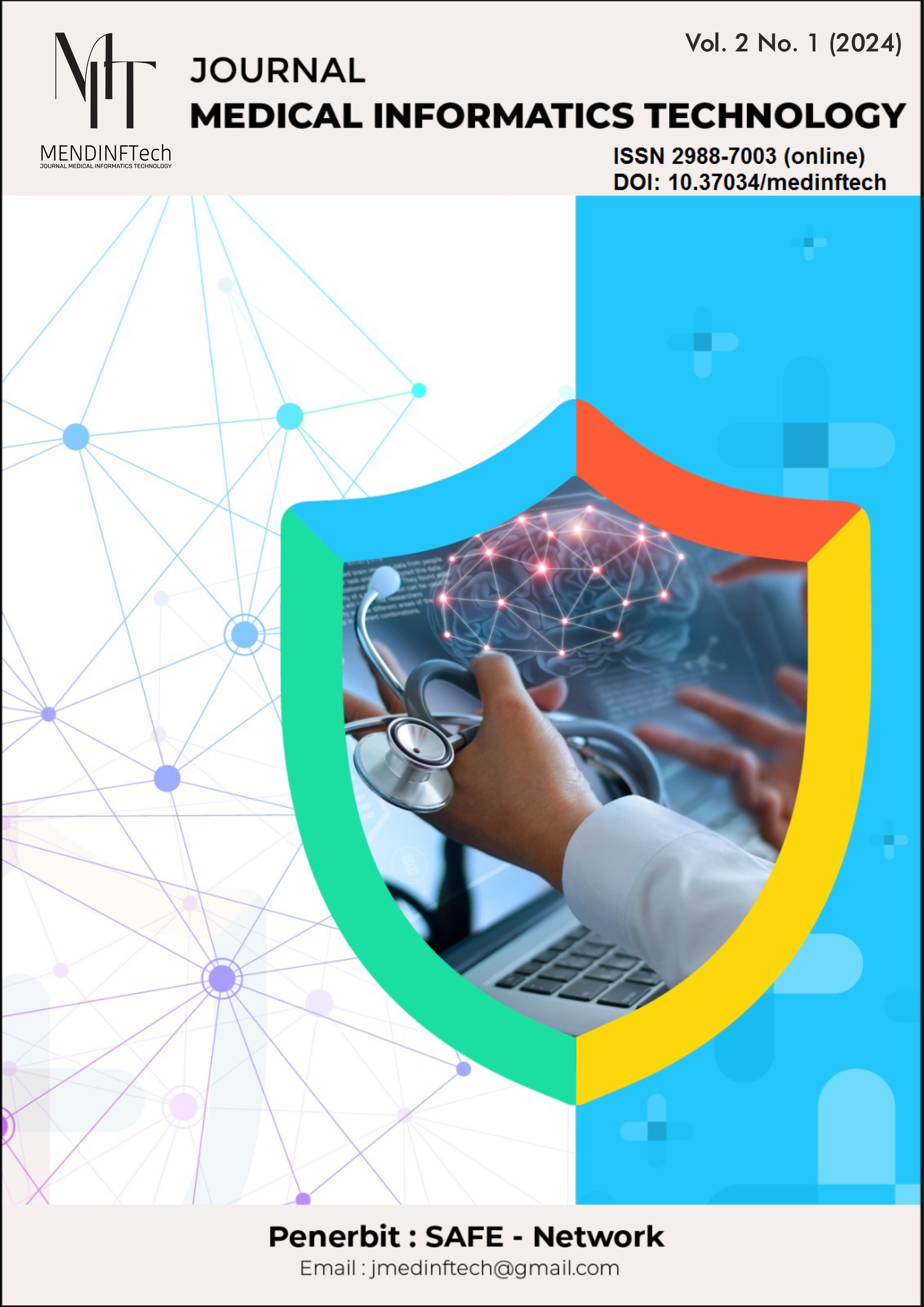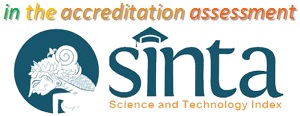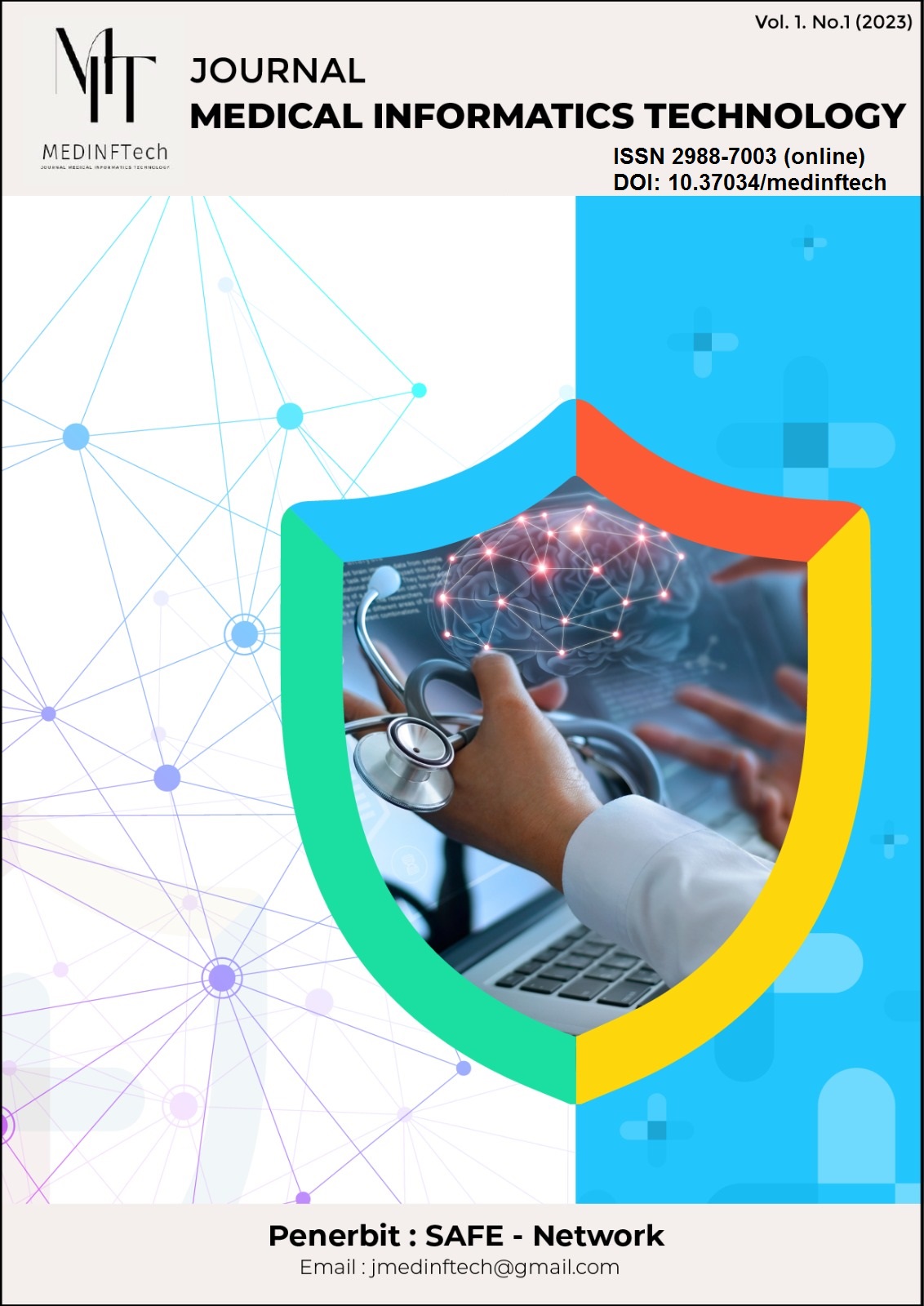Optimising Cataract Detection in Fundus Images through EfficientNet-Based Classification
DOI:
https://doi.org/10.37034/medinftech.v2i1.25Keywords:
Cataract, EfficientNet, Convolutional Neural Network (CNN)Abstract
Turbidity of the lens of the eyeball that causes blindness or loss of vision is known as a cataract. By diagnosing the causes and symptoms of cataracts, early detection helps patients in prevention and treatment. The purpose of the research was to classify the image of the fundus into two classes: normal and cataract. The study also looked at how the optimizers for stochastic gradient descent, adaptive moment estimation, root mean square propagation, adaptive gradient algorithm, adaptive delta, and Nesterov-accelerated adaptive moment estimation stacked up against each other. We used the EfficientNet architecture in CNN and preprocessed the normal fundus and cataract fundus images by dividing each into training data (N = 80) and validation data (N = 20) from the Kaggle repository. We added test data from the normal fondus image (N =20) to see the accuracy of the results. We get 100% accuracy of training data, 87% and 77% validation data, and 100% and 95% test data.
Downloads
References
Imelda, Eva, Rinaldi Idroes, Khairan Khairan, Rodiah Rahmawaty Lubis, Abdul Hawil Abas, Ade John Nursalim, Mohamad Rafi, and Trina Ekawati Tallei. 2022. “Natural Antioxidant Activities of Plants in Preventing Cataractogenesis.” Antioxidants 11(7):1285. doi: 10.3390/antiox11071285.
Jiao, Xiaodong, Mariia Viswanathan, Nadiia Fedorivna Bobrova, Tatiana Viktorivna Romanova, and J. Fielding Hejtmancik. 2022. “Molecular Genetic Analysis of Ukrainian Families with Congenital Cataracts.” Children 10(1):51. doi: 10.3390/children10010051.
Cicinelli, M. V., Buchan, J. C., Nicholson, M., Varadaraj, V., & Khanna, R. C. (2023). Cataracts. The Lancet, 401(10374), 377-389. https://doi.org/10.1016/S0140-6736(22)01839-6.
Kementerian Kesehatan RI. https://yankes.kemkes.go.id/view_artikel/891/katarak-kebutaan-yang-dapat-dicegah.
Zhang, Y., Gorriz, J. M., & Dong, Z. (2021). Deep Learning in Medical Image Analysis (458 pages). https://doi.org/10.3390/books978-3-0365-1470-3.
Purwono, A. M., Rahmaniar, W., Fathurrahman, H. I. K., Frisky, A. Z. K., & Haq, Q. M. ul. (2022). Understanding of Convolutional Neural Network (CNN): A Review. International Journal of Robotics and Control Systems, 2(4), 739-748. http://dx.doi.org/10.31763/ijrcs.v2i4.888.
Çeti̇Ner, H. (2023). Cataract disease classification from fundus images with transfer learning-based deep learning model on two ocular disease datasets. Gümüşhane Üniversitesi Fen Bilimleri Enstitüsü Dergisi. https://doi.org/10.17714/gumusfenbil.1168842.
Simanjuntak, R. B. J., Fu’adah, Y., Magdalena, R., Saidah, S., Wiratama, A. B., & Ubaidah, I. D. S. (2022). Cataract Classification Based on Fundus Images Using Convolutional Neural Network. JOIV : International Journal on Informatics Visualization, 6(1), 33. https://doi.org/10.30630/joiv.6.1.856.
Firdaus, D. H., Imran, B., Bakti, L. D., & Suryadi, E. (2022). Klasifikasi Penyakit Katarak pada Mata Menggunakan Metode Convolutional Neural Network (CNN) Berbasis Web. Jurnal Kecerdasan Buatan dan Teknologi Informasi (JKBTI), 1(3), 18-26.
Junayed, M. S., Islam, M. B., Sadeghzadeh, A., & Rahman, S. (2021). CataractNet: An Automated Cataract Detection System Using Deep Learning for Fundus Images. IEEE Access, 9, 128799–128808. https://doi.org/10.1109/ACCESS.2021.3112938.
Cahya, F. N., Hardi, N., Riana, D., & Hadiyanti, S. (2021). Klasifikasi Penyakit Mata Menggunakan Convolutional Neural Network (CNN). SISTEMASI, 10(3), 618. https://doi.org/10.32520/stmsi.v10i3.1248.
Syarifah, M. A., Bustamam, A., & Tampubolon, P. P. (2020). Cataract classification based on fundus image using an optimized convolution neural network with lookahead optimizer. 020034. https://doi.org/10.1063/5.0030744.
"Cataract Dataset." (2019). Kaggle. Retrieved October 20, 2023, from https://www.kaggle.com/datasets/jr2ngb/cataractdataset.
Eka Putra, W. S. (2016). Klasifikasi Citra Menggunakan Convolutional Neural Network (CNN) pada Caltech 101. Jurnal Teknik ITS, 5(1). https://doi.org/10.12962/j23373539.v5i1.15696.
Tan, M., & Le, Q. (2019). Efficientnet: Rethinking model scaling for convolutional neural networks. In Proceedings of the International Conference on Machine Learning (pp. 6105–6114).
Raza, R., Zulfiqar, F., Khan, M. O., Arif, M., Alvi, A., Iftikhar, M. A., & Alam, T. (2023). Lung-EffNet: Lung cancer classification using EfficientNet from CT-scan images. Engineering Applications of Artificial Intelligence, 126, 106902. https://doi.org/10.1016/j.engappai.2023.106902.
Uddin, M. J., Li, Y., Sattar, M. A., Nasrin, Z. M., & Lu, C. (2022). Effects of learning rates and optimization algorithms on forecasting accuracy of hourly typhoon rainfall: Experiments with convolutional neural network. Earth and Space Science, 9, e2021EA002168. https://doi.org/10.1029/2021EA002168









